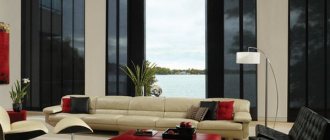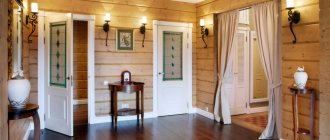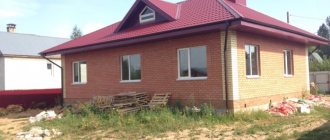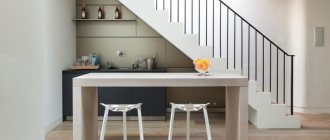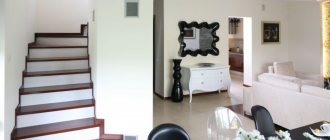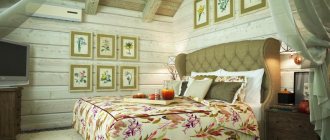For specific places named Octagon House, see Octagon House (disambiguation). For an extensive list of octagonal houses, see List of octagonal houses. For other octagonal structures in the United States, see List of octagonal buildings and structures in the United States.
McElroy Octagon House on Gough St. San Francisco, California; structural concrete structure (built 1861)
Octagon houses
were a unique house that was briefly popular in the 1850s in the United States and Canada.
They are characterized by an octagonal (octagonal) plan, often with a flat roof and a veranda around the perimeter. Their unusual form and appearance, very different from the typical ornamental pitched-roof houses of the period, can generally be traced to the influence of one man, the amateur architect and lifestyle maven Orson Squire Fowler. Although there are other octagonal houses around the world, the term octagonal house
generally refers to octagonal houses built in North America during this period and before the early 1900s.
CONTENT
- 1. History
- 2 Orson Squire Fowler 2.1 Advantages of the Octagon Plan
- 2.2 Design principles
- 2.3 Construction of Masswall
- 2.4 Fowler's Folly
- 4.1 Plan geometry
- 6.1 History
Designing Canadian Homes: Key Points
1) You should like the house design!
How their owners like these sip houses.
2) Be stylistically integral.
3) Be comfortable for all family members and pets, if any.
Watch our video: “The best size and layout of a Canadian house made of sip panels for a family of 3 people. Comfortable and budget option.”
4) Provide the opportunity to build a house that is optimal in price.
And it doesn’t matter whether it is “premium” or “economy” class - you must be sure that you will fit into the planned budget in any case.
Read our article “Rational design of your home. Useful Tips."
5) Be “not like everyone else.”
Standard solutions are good because they are “time-tested,” but they are often boring and monotonous.
And today we want to talk about a non-standard approach to the design of Canadian sip houses.
The technology for building houses from sip panels is not only warm, energy efficient and reliable, but also flexible - it allows you to realize any flight of fancy - build a house according to absolutely any project!
History[edit]
Early examples, before Fowler:
- Poplar Forest, Thomas Jefferson's private retreat and plantation home near Lynchburg, Virginia.
- William Thornton's John Tayloe III House, more commonly called The Octagon House [1] in Washington, D.C. After the White House was burned by the British during the War of 1812, President James Madison remained at the Octagon, and it was here that the Peace of Ghent the treaty (ending the War of 1812) was signed. It is now the headquarters of the American Institute of Architects. Although this building is known as "The Octagon", it is worth noting that this particular building is not actually octagonal.
Both houses are large brick buildings in the classical tradition. They can be seen as predecessors, but they are somewhat different from Victorian octagonal houses, which are essentially domestic structures.
Severity of style, originality, functionality at the same time
Due to natural conservatism, each of us tries not to stand out, we are afraid of being branded as a black sheep.
This applies to construction and architectural claims. And at the same time, would anyone refuse to erect an unusual, beautiful and functional structure, near which people would slow down, amazed at the boldness of the forms and the severity of the taste? Numerous construction forums are replete with questions from uninitiated beginners and detailed discussions from experienced gurus about the new round of frame construction fashion for six- and octagonal houses that came from Norway. Surprisingly, the optionality of such an obtuse-angled structure turns out to be higher than the usual parallelepiped.
But changing the geometry of the interface between walls and the rafter system will require greater professionalism and responsibility of the developer or hired team. However, the game is worth the candle; more technically complex log buildings of worship are still pleasing to the eye to this day. The apparent airiness of the fortress and temple octahedra deceives the eye - visually they are much smaller than in reality.
Orson Squire Fowler[edit]
The leading proponent of octagonal houses was Orson Squire Fowler. Fowler was America's leading lecturer and writer on phrenology, the pseudoscience of determining a person's characteristics based on the contours of the skull. In the mid-19th century, Fowler made his mark on American architecture with his widely publicized book, The Octagon House: A Home for Everyone or New, Cheap, Comfortable.
advertised the advantages of octagonal houses over rectangular and square ones.
, and Superior Mode of Building
, printed in 1848. [2] As a result of this popular and influential publication, several thousand octagonal houses were built in the United States, primarily in the Midwest, East Coast, and nearby areas of Canada. [3]
Advantages of the octagon plan[edit]
Compared to a square, an octagon covers approximately 20% additional space with the same perimeter.
According to Fowler, an octagonal home is cheaper to build, provides additional living space, receives more natural light, is easier to heat and stays cooler in the summer. All of these advantages stem from the geometry of the octagon: the shape effectively encloses space, minimizing external surface area and resulting heat loss and loss, construction costs, etc. The circle is the most efficient shape, but is difficult to construct and awkward to furnish, so the octagon is a reasonable approximation. Victorian builders were accustomed to constructing 135° angles, as in a typical bay window, and could easily accommodate an octagonal plan.
Design principles[edit]
"Octagon House"
Fowler is sometimes mistakenly called a pattern book, but the book's popularity lies in the fact that Fowler suggested some general principles and encouraged readers to make up the details for themselves. Only a few examples are offered, and besides the plans, the book has only two illustrations showing what an octagonal house might look like.
First, it shows some ways to subdivide an octagonal floor plan. What follows is Howland's octagonal plan
, a small house designed by Messrs.
Morgan and Brothers, the architects, which is similar to the Norrish house shown below. What follows is a description of the author's own residence
, now known as Fowler's Folly, in Fishkill, of which more below.
Finally, an excellent plan for a good sized home.
, which is a development of Fishkill's plans apparently proposed by its engraver. The main feature of his plans is the desire to eliminate unnecessary circulation space, sometimes to the point that the front staircase becomes inconvenient, and the external porch is the best way to move around the house. Fowler was not an architect, and in a sense his theories needed an architect to bring them to a workable conclusion.
Other design suggestions include:
- Flat rainwater harvesting roof with built-in cisterns for collecting and distributing water.
- Filtration of rainwater using filter layers consisting of alternating layers of sand and activated carbon.
- Central heating by distributing hot air from a furnace in the basement.
- Chimneys, air ducts and speaking tubes are built into the thickness of the walls.
The examples constructed vary greatly in the degree to which this influence is evident. Although the Watertown house is made of brick, it is a near-perfect embodiment of many of Fowler's ideas.
Construction of Masswall[edit]
In the first edition of the book “A Home for Everyone”
[4] the use of sandwich boards was recommended, but the third edition of Fowler's book, printed in 1853, added a new subtitle: A
House for Everyone, or Gravel Wall and Octagon
, and featured Fowler's enthusiasm for concrete construction. He seems unaware that concrete has been in use since Roman times, crediting the discovery to Mr. Goodrich of Janesville, Wisconsin, and crediting himself with developing and popularizing the technique. Fowler knew that gravel and lime were available in unlimited quantities on the prairies and believed that the "gravel wall" offered a new, cheap and reliable way of building. His house in Fishkill was built of concrete. The walls were built several feet at a time by pouring a mixture of gravel and lime into wooden forms. As the concrete hardened, the formwork could be removed and moved to the next level.
Modern concrete is made using Portland cement, rather than lime, but the main difference is the versatile use of steel reinforcing bars, which greatly increases the strength of the material and allows the construction of concrete beams and floor slabs as well as walls. Fowler used large stones to strengthen the corners, but did not use any other fortification, and therefore limited himself to walls. Thus, the roof, floors and verandas are made of wood.
Fowler's Madness[edit]
According to Fowler, "...those studies that led to this work were undertaken in the first place to build this very house." Construction began in 1848, the same year his book was first published, and took five years to complete. The house was large, 42 feet on each side of the octagon, or 100 feet across, and was built on top of a hill overlooking the Hudson River, from where it could be seen for miles around. Fowler removed the top of the hill to create a level area and provide material for his "gravel walls". This grand residence featured four enormous reception rooms that could be interconnected depending on the size of the event, supposedly 60 rooms (including small dressing rooms as well as regular rooms), and a glass dome rising 70 feet above the ground. Fowler's favorite writing room was an interior room on the third floor, lit only from the dome through a fan light above the door. The house had no central staircase, so visitors entered one of the main rooms through a small vestibule, while the family and staff used the basement entrance. Around the house there are verandas on the first, second and third floor levels, connected by two external staircases.
The financial panic of 1857 led Fowler to rent the house, which subsequently passed through a series of owners. Fowler's Folly fell into disrepair and, finally deemed a danger to the community, it was blown up in 1897 by Fred C. Haight, a demolition engineer for the city of Fishkill.
Central support
With a floor area of a frame house over 50 sq. m installation of a central support is required. In addition to supporting the strapping, it will become the unloading axis of the rafter system of the roof dome. There are good examples of pushing the boundaries of loaded axle use. The material of manufacture is not regulated, but if you plan to use a stove or fireplace, then, definitely, brick.
Exhaust ventilation and a chimney are adjacent to it. It will also serve as a support for the stairs. Being the natural geometric middle of the room, it divides it into zones.
It is worth using your imagination so that the internal vertical carries the semantic load of the core of the house, not only dividing, but also simultaneously uniting living spaces.
Surviving examples[edit]
Estimates vary, but hundreds of these Victorian-era homes are still standing across the United States and Canada. One estimate puts the number at 2,077. [3] Even in their heyday, octagonal houses were never mainstream - on the contrary, the octagonal house seemed to be the choice of individualists, causing defiance among four-sided neighbors.
The largest remaining octagonal houses in the United States are Longwood in Natchez, Mississippi and the Octagonal House in Watertown, Wisconsin. [ citation needed
] Both houses are open to the public. In eastern Washington State, it still stands where it was moved in 1993, to Bridgeport, near the Columbia River.
Fowler was an influential but not the only proponent of octagonal houses and other buildings. There are also octagonal barns, schools, churches, and in Canada, octagonal "dead houses".
Interior design – the standard of minimalism
The miniature home has a custom 1920s style with a tiled shower room and sink, as seen in the photo. The couple named their house "Tiffany".
Tim says: “Tiny houses are very affordable for those looking to buy their first home. "You can get a fully equipped home for as little as $20,000 to $30,000, or even $10,000 if you don't care about the bathroom."
Sam added: “The tiny house is also very durable. The Tiffany is not hurricane resistant, but it has already survived a major storm. Sometimes it can be a little challenging to host guests, but we are resourceful. If friends come over, they sit at the counter, and we sit on the stairs.”
Roskomnadzor versus Twitter: what to expect for Russian Internet users
A new “chimeric” vaccine has been developed against different subtypes of influenza A
In the new show “TikTok talent” Larisa Guzeeva promised to look for real geniuses
Design options[edit]
Within the central idea of an octagonal plan, these houses show great variety in both design and appearance. They range from the modest two-story Bevis-Tucker House to the grandiose Armor-Stiner House [5] (both shown below).
Plan geometry[edit]
A complete octagonal house has 8 equal sides, although slight variations in length are not unusual. This is in fact the most common form, but in some cases the main octagon is partially hidden by additions, either around the entire perimeter, as in Holmes's House of Zelotis, or by the addition of a functional wing hidden from rear view. The House of Seven Gables in Mayo, Florida has gables on seven sides and the eighth side extends to the rear. Richard Picon's house in Key West, Florida, looks like a complete octagon from the street, but the back is square.
Materials [edit]
Fowler advocated the use of a "gravel wall" design for the walls. [6] This was an experimental method at the time, and although some were built this way, most octagonal houses were built in the same way as regular houses, using timber frames, brick or stone.
Future plans
Now the couple has bought another piece of land to create an off-grid community in Florida where they can add four tiny homes.
They have already completed construction of their second octagon, which can withstand Category 5 hurricanes. And although the couple admitted that some people think they are “crazy,” they believe their idea will work.
Tim explained that there is enough space on the island for four or five houses: “We have enough space for the neighbors to join us here. We are trying to renovate the Tiffany so that it can be completely self-sufficient—powered by solar energy. There are many fruit trees on the island, so we have the opportunity to become self-sufficient.”
Found a violation? Report content
Examples of octagonal houses[edit]
Below are examples of "real" octagonal houses and a range of possible designs.
- A modest frame house with a flat roof. Bevis Tucker House, Chelsea, Massachusetts.
- Large frame house, pitched roof and lantern, veranda around the perimeter. Arched windows and window shutters add a decorative touch. Rich-Twinn Octagon in Akron, New York.
- A small but decorative wood frame house painted in "period" colors that may reflect the original color scheme. Octagon House, Barrington, Illinois (built 1860).
- An ordinary brick house without any decorative elements, except for a modest veranda in front of the house. Robert Waugh House, Sparland, Illinois (built 1886).
- Magnificent octagonal brick house with veranda, pitched roof and clerestory. Wilcox Octagon House, Camille, New York (built 1856).
- A brick house with a second floor of a wooden frame built into the roof structure, which is unusual. Gregg-Creath Octagon House in Circleville, Ohio (built 1855–1856).
- Similar arrangement of brick masonry on the first floor and wood frame on the second floor, but built in a typical San Francisco decorative style. Feusier Octagon House, San Francisco, California (built 1857).
- A very simple house, the walls are made of limestone and finished with cement plaster. Features are typical of Fowler's influence: a wraparound veranda, flat roof and central clerestory. Norrish House, Hastings, Minnesota (built between 1857 and 1858).
- An even simpler house, although slender, without a veranda, only with a porch. Octagon House, Wallingford, Connecticut (built in the 1850s).
- The concrete house is a Fowler "gravel wall" design - with cement plaster made to look like masonry. McElroy Octagon House, San Francisco, California (built 1861).
- Another example of concrete construction. A variation of a pure octagon with square wings extending on four sides. Zelotes Holmes House, Lawrence, South Carolina (built 1859).
- A large ornate house with a level of decoration usually associated with public buildings. The original house, which was more modest in design, was built in 1860, and the dome was added in 1872–1876. Armor – Stiner House, Irvington, New York. [5]
What difficulties await you with insulation?
Regardless of the design features, the construction stages of a conventional frame house are completely preserved. The fundamental difference is in the geometric component. First of all, this concerns insulation. With traditional mineral wool you won't have any headaches. There will be a lot of cutting and joining. Floors are the most difficult area. The radial divergence of the joists and rafters will incredibly complicate the uniform filling of the insulator. Walls tapering inward will add their own problems.
Filled foam-forming thermal insulation breathable reagents will help to significantly speed up the insulation process. For a frame house, the passive removal of condensing moisture from the wall filler is extremely important to preserve the thermophysical properties. Therefore, it is preferable to use well-proven penoizol - this insulation does not lose its physical properties throughout the life of the home and conscientiously removes moisture due to its porous structure.
Case study: Octagon House in Watertown, Wisconsin[edit]
Main article: Octagon House (Watertown, Wisconsin)
Octagon House in Jefferson County, Watertown, Wisconsin (built c. 1854), photographed in 2007
Photo, date unknown. When the record drawings were made, the house was dilapidated, there were no verandas: only the entrance veranda is visible here. The verandas were restored in 1973.
Although the Watertown house is one of the largest, it falls midway between the grandest and most modest surviving examples. It is well documented, [7] and has been carefully restored and is open to the public as a museum. [8]
History[edit]
Construction was completed in 1854. The house fell into disuse and was given to the newly founded Watertown Historical Society and opened to the public in 1938. The house still belongs to the Society.
Construction and innovation[edit]
- The plan is a 50-foot (15 m) octagon with a 4-foot-8-inch (1.42 m) perimeter veranda at the first and second floor levels.
- The house is built on a 17-inch (430 mm) thick stone foundation with 13-inch (330 mm) thick brick masonry exterior walls.
- The central area is formed by two 4-inch (100 mm) sheets of masonry with a 4-inch (100 mm) cavity, which is used for chimneys and warm air ducts to heat rooms without fireplaces. The double wall eliminates the need to protrude into the chimney pile.
- The battlement effect on top of the dome actually represents four chimneys.
- A stove in the basement heats the water, and the warm air is directed to the twelve main rooms, that is, those adjacent to the central square.
- All floors are connected by an elegant spiral staircase. It is self-supporting internally and is built into the walls outside the stairwell. There is also a servants' staircase.
- The house has a flat roof, sloping towards the center.
- Rainwater from the roof was collected in a tank at the third floor level and overflowed into a tank next to the kitchen in the basement.
- Publications regularly claim that the house has 57 rooms; however, this includes all restrooms and aisles. The number of living rooms is 29, including an octagonal room in the dome.
- Although the house has 15 bedrooms, there is only one bathroom.
Architectural style[edit]
The house was inspired by Fowler's book and is a good example of his theories being brought to life. In addition to the octagonal plan, the central spiral staircase, the symmetrical arrangement of rooms with connecting doors, the verandas running around the perimeter of the building, and the flat roof topped with a dome are directly related to his ideas. In keeping with Fowler's theories, the detailing is relatively simple for the period. The openings are simply framed with moldings. Covered porches are free of unnecessary detail and feature modest turned balustrade spindles and support posts. The decorative effect of the house is due to the main design features: the octagonal shape and external verandas.
Pros and cons of the octagon plan[edit]
This is where the typical effect of Fowler's concern for saving space comes into play. There are four spacious rooms on each floor, nearly 18 feet square, with connecting doors on all sides. The auxiliary premises are less satisfactory, being triangular in shape. The arrangement of the rooms is strictly the same on all floors because the partitions are made of 9 inch (230 mm) brick masonry, so they must be located on top of each other. The central spiral staircase is compact, but leaves one side of the house without direct access to the landings, so the bedrooms can only be accessed through another bedroom - at worst, through the other two bedrooms. The shortcomings of this scheme are again a legacy of Fowler's influence, the reluctance to sacrifice the spaciousness of the rooms in favor of reasonable circulation mechanisms. Fowler's own house had external stairs and verandas were used for movement and access to rooms.
Record drawings [edit]
Below are drawings of the Watertown Octagonal House dated March 28, 1935, prepared by the Historical Survey of American Buildings. There were no verandas at that time, they were removed when they became dangerously rotten. The survey drawings are a reconstruction of the house as it was built.
- Ground floor (basement) and first floor plans.
- Plans of the second and third floors.
- Front view.
- Exterior details: front door and windows.
- Interior details: main spiral staircase, door frames and skirting boards.
- A photograph possibly dating from 1856 showing the house in its original condition.
Foundation
A columnar foundation with the obligatory addition of a gravel-sand mixture to the base is preferable. With an advantageous high base, which allows you to overcome the natural squatness, it becomes possible to make the cover of the base from lightweight materials, and use polystyrene foam from the inside as insulation.
Additionally, we are purchasing a semi-basement floor, which can be used as a warm garage, workshop and as utility rooms for other purposes. Additional support under the geometric center is desirable even with a small floor area - in order to avoid sagging of the lower frame.
Links[edit]
- Washington, DC - Octagon House Washington, DC Octagon House
- ↑
The Octagon House, Orson S Fowler: Dover Publications, Inc., first edition 1848, edition 1853, reprinted 1973. - ^ ab Orson Squire Fowler: Phrenology and Octagonal Houses 1809-1887 by John H. Martin.
- H. Ward Gendle, John A. Burns, Michael Auer. Yesterday's Homes of Tomorrow: Pioneering American Homes from 1850 to 1950. Preservation Press, 1991. 49.
- ^ab Lombardi, Joseph Pell. "Armor-Stainer (Octagon) House Irvington-on-Hudson, New York". Archived from the original on October 29, 2011. Retrieved November 10, 2011.
- Jump up
↑ Northeast Journal: Fowler's Folly, Fishkill, NY - Library of Congress, Prints and Photographs Division: Drawings and Photographs from the Historic American Buildings Survey
- Watertown Historical Society
Further reading[edit]
- Baker, John Milnes. American Home Styles: A Quick Guide.
New York: W. W. Norton & Company, 2002. - Puerzer, Ellen L. Inventory of the Octagonal House.
Publishing house "Eighth Square", 2011. - Rempel, John I. Building with Wood
. Toronto: University of Toronto Press, 1967. - Schmidt, Karl F. The Octagon Quirk.
1958 - Schmidt, Carl F. and Philip Parr. Read more about octagons.
1978 - Gonsalves, Eliseu. The Octagon at Orson Fowler's Homes.
Nexus Journal, vol. 13, no. 2. Basel: Springer/Birkhauser, 2011. - Fowler, Orson S. with a new introduction by Madeleine B. Stern. "The Octagon House: A Home for Everyone", Dover Publications, 1973.

